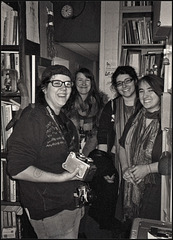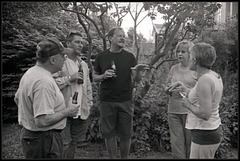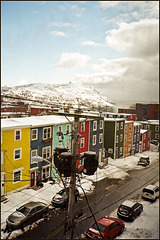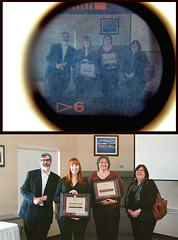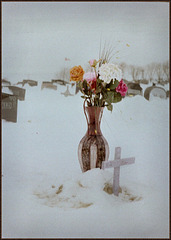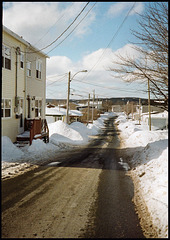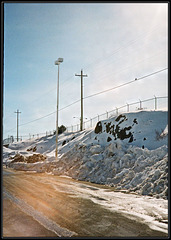Justfolk's photos
Comparing cameras
| |
|
|
|
I just developed this roll of film which was shot two years ago, in
March of 2012, and I cannot remember precisely the kind of camera that
Kat, at left, had around her neck. I think it was a Pentax K1000. In
her hand is the heavy Mamiya C220 I have in the office. Kat was
visiting her friend Jules, on the right, from thousands of miles away
and Jules said she should meet me because we could talk cameras.
That's what we did do. There were four friends together (Amy and
another Kat in between); I had them all squeeze in so I could take
their picture together.
This was on 1990s-era Tri-X in my Mamiya U. I developed the film
yesterday in some leftover T-Max developer that I opened in 2002. It
keeps well.
Warm evening
| |
|
|
The spring equinox is only three hours away; we'll officially be in
the spring season then. But the temperature is still below freezing.
Days like the one in this picture seem pretty distant.
This was two summers ago, late July 2012, but I have only now
developed the film. It was Tri-X in my Minolta Hi-Matic 7sii. There
is a lot of nice stuff written about the 7sii but I've never really
liked mine. The lens is very soft, and especially so at the open
apertures I tend to use. The Tri-X was film I bought in the mid- or
late 1990s. I've still got a half-dozen rolls of b&w film from that
period.
Scanned (Epson V700) from the negative, with curves adjustments (and
border) in Paint Shop Pro X5.
After supper
| |
|
This was after a delicious supper with a bunch of old friends.
Using colour film in low light often makes me want to turn the
pictures into black-and-white ones. That was the case with this shot,
originally on Fujicolor 200 in my Olympus 35DC, a nice little
fixed-lens rangefinder with a fast lens. I used a couple of
different colour filters (in PSP X5) to get different tonal gradations
in various parts of the picture.
I should be using Tri-X again. Or something slower -- the tones and
grain here remind me of Plus-X, though it's not nearly as sharp as I'd
have expected from that late, lamented film.
A year ago when it was milding up a bit
| |
|
|
This was taken a year ago. It looks nothing like this now as we have
had little mild weather this March.
Of course it looked little like this last year, too, since this
picture is a result of shooting 25-year-old film in a 126 camera.
Somewhat distorted representation of reality. Kodacolor VR-G
(expired April 1989) in Yashican E-Z matic.
Pedestrian path, ploughed
| |
|
|
|
It's a rare bird in this town, a sidewalk having been ploughed in the winter.
Kodak Colorplus 200 in Konica Eye2.
Flare, crow, fence, snow
Slavi
| |
|
Slavi dropped by to talk about place-names. We discovered a mutual
interest in camera and he let me take his picture.
This was Colorplus Kodak 200 in the Konica Eye2. A little cropped at
the top; dodged & burned all over.
Oranges for them
Winter winter winter
| |
|
|
This was a week ago when it was a dozen degrees below zero (Celcius).
(Nearly) monochrome season.
Kodak Colorplus 200 in Olympus XA.
Looking down King's Road
| |
|
|
I went to school for the first eight years of my education in this
neighbourhood. My school is just across the intersection that is
immediately to the left of this picture.
My father was an electrician, among other things. I wonder if that's
why I *like* pictures of power lines.
Kodak Colorplus 200 film in Olympus XA
King's Road at Bond Street
| |
|
|
I went to school at this corner. The school I went to from
Kindergarten until Grade Seven is just out of sight here to the right.
So this is a very familiar neighbourhood. Where Lawlor's is now,
there was an old-fashioned "groc & conf" shop when I was a boy. I
spent a lot of the money earned on my paper route in that shop. A
grocery wholesaler was in the building painted with cow clouds. And
my first barber had his shop across from there. This picture was taken
from the third floor of a small office building that did not exist
back then. It was built in a corner of the grounds of another school.
Kodak 200 film in Olympus XA.
Pocketknife
| |
|
|
I own a lot of pocketknives. I started carrying them as a child and
have never stopped. When my father died fifteen years ago, I
inherited his. And over the years, I've found a couple in the street.
That's how I got this one. It was fairly beat up from having been
driven over through at least part of a winter but it serves its
purpose, which is to be a tiny folding knife. Open, it is only ten cm
long and folded less than six. It has a good blade, the base of which
is seen here.
This was another test of using a cheap plastic loupe as a close-up
lens in front of a cheap 3MP digital camera (Olympus Camedia C3020).
It's pretty good, and I'm going to try it some more.
Low tech "scanning"
| |
|
This was an attempt to see what a cheap digital camera and a plastic
loupe would do in copying a negative. The negative was a not-bad shot
in a Nikon APS slr a couple of years ago. It had limitations to begin
with -- it was on expired FNAC film, a film notorious for its lack of
clarity. Nonetheless, this image wasn't bad in the original.
I taped the negative (still in its plastic PrintFile sleeve) to a
sheet of white paper which I taped to a north-facing window. The north
window was chosen to avoid the sunlight that is streaming in the
south-facing ones this morning. The texture in the image is largely
the fibre patterning in the paper but probably has something to do
with the plastic sleeve, too. I set the Olympus Camedia C3020 to its
flower icon, meaning it was looking for close focus, and I simply held
my little Agfa plastic loupe (8x) on the front of the camera's lens.
With the flash turned off, I took this picture. Done that way I could
hold the camera fairly steady for its 1/20 second exposure. I did
very little in adjustment -- in Paint Shop Pro, I inverted the image
colours and then adjusted the colour curves a little bit.
Adjusting the loupe-to-lens distance (to gve bigger coverage of the
negative), using a better negative to begin with, and using a less
fibrous paper backing (or a proper light table) would all improve this
result, if by "improvement" you mean making the image look more like
something you'd taken originally in the same digital camera. But I
like the introduction of shape distortion (pin-cushion distortion?),
the textural quality, and the circular image.
Fresh flowers
| |
|
|
It must have been a new grave since it was marked with only a
handwritten wooden marker, but it was covered with fresh snow so I
couldn't really tell. Someone had brought a large and beautiful vase
with fresh flowers. It was a dark and blowy-snow day, and the
temperature was minus 13 Celcius. The flowers could not have been
there very long.
Kodak Colorplus 200 in Konica Eye2.
Pearce Avenue in the West End
| |
|
|
Pearce Avenue is not a wide street. These days the city allows cars
in only one direction. In winter that saves on ploughing effort.
Kodak Colorplus 200 in Konica Eye2.
A good-looking day
Someone turned out the light
| |
|
Walking through one of the neighbouring graveyards, I saw this lamp shade.
Kodak Colorplus 200 film in Konica Eye2.
Springe tide in March 2010
| |
|
This was four years ago; the following year a really high tide
finally lifted the remains of that big wharf off its piers and carried
it away. The high and low tides are called springes, though some
people call the lowest tides, like this one, the nips.
These two pictures were taken on expired Fuji Sensia slide film in the
Rollei 35TE. In lining the pictures up for this, I had two big white
areas that I very roughly faked image into. I didn't try very hard at
that and, to reduce the appearance of fakery and joinery, I noised the
edges of the picture substantially.

